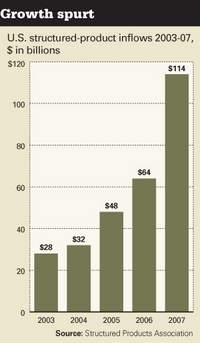But Consider Cost, Liquidity, Complexity
It seems like the perfect pitch for retirees: a financial product that protects principal and offers some growth potential to help fight inflation.
Or, still a decade or so from retirement but needing to boost returns to hit your number? Another product won't protect your downside but promises twice the market's positive return.
These are just two examples of the booming structured-products industry, which last year saw new U.S. issuances jump 44 percent from 2006, to $114 billion, according to the Structured Products Association, a New York-based trade group.
Behind the appeal of enhanced returns or insuring investors' principal, however, are concerns about the products' cost, liquidity and complexity for retail investors.
Financial institutions sell the notes under a variety of names in increments as low as $1,000, offering returns linked to particular market results over a period of time, say, three to eight years. One type of note might offer twice the return of the Standard & Poor's 500 index if it goes up (subject to a cap), but would have full exposure to any decline.
Another type might cap positive returns at a slightly lower figure but offer some downside protection — say, covering the first 10 percentage points of loss.
In the case of principal-protected notes, the contracts might be a hybrid of an FDIC-insured certificate of deposit issued by a bank and an option on the S&P 500 index issued by a brokerage firm. The investor essentially would receive the return on whichever performed better.
Many mutual fund companies and brokerages offer structured products on their trading desks, though often it involves a phone call to a representative to get to a full menu of all the notes being provided. Big players include JPMorgan Chase, HSBC, Morgan Stanley and Merrill Lynch.
Fees typically are embedded into the products, so consumers may find it difficult to comprehend total costs. There are underwriting fees to the banking firm that creates the product and brokerage commissions that combined could exceed 3 percent of an initial investment. Tack on ongoing management fees and the implied costs of caps on earnings.Some buyers have taken to the secondary market — financial exchanges — to escape the issue costs, but the flip side is that sellers trying to unload the products before the term expires have at times been stung by that illiquidity.
One concern is issuer risk. Given the problems in mortgage-related and other derivatives, consumer advocates worry that retail investors could get swallowed up in a round of defaults.
The derivative products also don't pay dividends like you'd receive if you made a direct investment in a stock-index mutual fund.
Saturday, May 24, 2008
Subscribe to:
Post Comments (Atom)



No comments:
Post a Comment